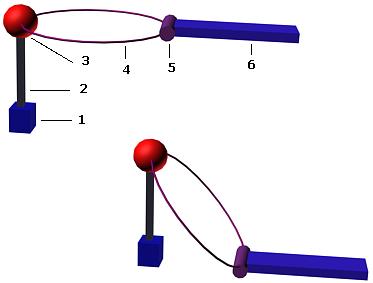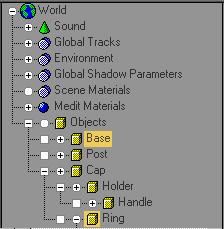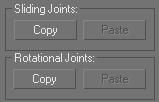
You set whether a joint behaves as a hinge, a drawer slide, or another type of joint by setting joint parameters for each object in the kinematic chain. Joints control the rotation and position of an object with respect to its parent.
Any object has a maximum of two joint-type rollouts. One rollout contains settings to control the object's position. The other rollout controls the object's rotation. There can be many different types of positional and rotational joints. Which joint parameters are available is determined by the whether or not an IK solver is assigned to an object. IK Limb solvers, for instance, are controlled with a preferred angle setting found in the Rotational Joint parameters. Object hierarchies that have no solver assigned have different parameters for joint limitation, including controls for spring back, precedence and damping.

1. base
2. post
3. cap
4. ring
5. holder
6. handle


The two joint types are Rotational and Sliding joints. Each joint type displays its own set of joint parameters.
Rotational joints: Control rotation of objects using many of the standard rotation controllers. The parameters for rotational joints set an object's ability to rotate about a given axis.
For many IK structures, consider using an Euler XYZ controller. Quaternion-based controllers tend to freeze if an object is moved beyond rotational joint limits before turning on IK.
Sliding joints: Control the position of objects using many of the standard position controllers. The parameters for sliding joints control whether an object can move along a given axis. To use sliding joints in gmax, set up the joint limits on the hierarchy with no IK solver, then use Interactive IK to animate the sliding joint.
Surface joints: Control the position of objects using Surface constraint. The parameters control how the object travels along its assigned surface.
Path joints: Control the positional motion of objects using Path constraint. The parameters for path joints control how far an object can travel along its assigned path.
Tip: When you are using an object with a path constraint in an IK chain you might want the path to appear as if it is part of the IK chain. You achieve this effect by linking the object using the path constraint and the path to the same parent. The path object should have no children, and other objects in the IK chain should be linked to the object using the path constraint.
In the figure, the bead uses a path constraint to hold it to the ring. The IK chain from parent to child is Post->Cap->Bead->Handle. The ring is a child of the Cap but is not part of the IK chain.
You can copy and paste at the bottom of the Object Parameters rollout in the Hierarchy panel to copy and paste a complete set of joint parameters from one object to another.
There are separate copy and paste functions for sliding joints and rotational joints. Each joint type saves copied parameters in separate clipboards.
Tip: Choose one of the Mirror Paste options if you want to mirror the joint parameter settings as you paste them. This is very useful when pasting from one side of an object to another, such as left arm joints to a right arm.